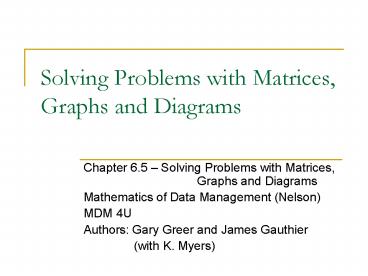Solving Problems with Matrices, Graphs and Diagrams
1 / 9
Title:
Solving Problems with Matrices, Graphs and Diagrams
Description:
In mathematics and computer science, a graph is a ... is the branch of mathematics that examines the properties of ... of applied mathematics. ... –
Number of Views:29
Avg rating:3.0/5.0
Title: Solving Problems with Matrices, Graphs and Diagrams
1
Solving Problems with Matrices, Graphs and
Diagrams
- Chapter 6.5 Solving Problems with Matrices,
Graphs and Diagrams - Mathematics of Data Management (Nelson)
- MDM 4U
- Authors Gary Greer and James Gauthier
- (with K. Myers)
2
Graph Theory
- In mathematics and computer science, a graph is a
generalization of the simple concept of a set of
dots, called vertices, connected by links, edges.
Depending on the applications, edges may or may
not have a direction vertices and/or edges may
be assigned labels. A numeric label is often
called a weight. - Graph theory is the branch of mathematics that
examines the properties of graphs. - Informally, a graph is a set of objects called
vertices connected by links called edges - Wikipedia (2004)
3
Terminology
- sequential tasks are dependent on each other and
must be performed in order - a project graph is a digraph on which each task
to be completed is represented by a vertex - in a project graph, the weight of an edge is the
duration (to completion) of a preceding task
4
Terminology (continued)
- parallel tasks are independent and can be
performed at the same time - critical path analysis is the process of finding
the optimal way to complete a complex task - earliest start time the earliest that a task can
begin if all tasks on which it depends begin as
early as possible
5
Another Term Task Table
- a task table is a table that lists all tasks
associated with a project... - ... including the duration of each task and the
tasks on which each depends.
6
What is OR?
- Known in the United Kingdom as Operational
Research and as Operations Research in North
America, OR is the use of mathematical models,
statistics and algorithms to aid in
decision-making. - OR is most often used to analyze complex
real-world systems, typically with the goal of
improving or optimizing performance. - It is one form of applied mathematics.
- The Royal Air Force (RAF) and the Royal Navy
began to study operations in the 1930s as a way
to make the armed forces more efficient.
7
OR (continued)
- After World War II, OR methods spread to other
nations. Government, military and industrial
sectors now regularly employ OR. - OR is a bit of a misnomer... it is no longer
concerned only with operations, nor does its
application involve any research in the
traditional sense (although OR research is still
carried out to find new and better techniques). - The growth of OR is, to a large extent, the
result of the increasing power and widespread
availability of computers.
8
OR Links
- Operations Everything (Article from the Boston
Globe) - http//www.orie.cornell.edu/
- http//www.coe.ubc.ca/
- http//www.brunel.ac.uk/depts/ma/research
/jeb/or/intro.html - http//en.wikipedia.org/wiki/Operations_research
9
Exercises / Homework
- Read pp. 374 - 378
- most of our 6.5 problems will look like example 1
or example 2 - Homework
- page 379, 1, 3, 5
- page 380, 6
- page 381, 7































